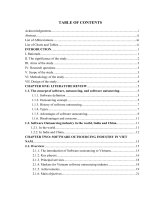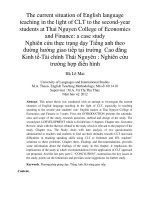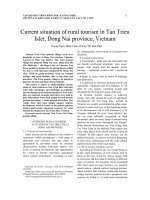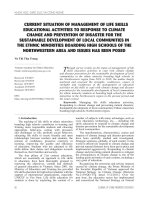current situation of outsourcing development, a number of favorable factors promoting this industry as well as analysis of outsourcing activities FPT Software.doc
Bạn đang xem bản rút gọn của tài liệu. Xem và tải ngay bản đầy đủ của tài liệu tại đây (449.22 KB, 79 trang )
TABLE OF CONTENTS
Acknowledgements.....................................................................................................i
Abstract.....................................................................................................................ii
List of Abbreviations................................................................................................iii
List of Charts and Tables...........................................................................................iv
INTRODUCTION...................................................................................................1
I. Rationale.................................................................................................................1
II. The significance of the study.................................................................................2
III. Aims of the study.................................................................................................2
IV. Research questions...............................................................................................3
V. Scope of the study.................................................................................................3
VI. Methodology of the study.....................................................................................3
VII. Design of the study.............................................................................................4
CHAPTER ONE: LITERATURE REVIEW........................................................5
1.1. The concept of software, outsourcing, and software outsourcing.................5
1.1.1. Software definition ..................................................................................5
1.1.2. Outsourcing concept.................................................................................5
1.1.3. History of software outsourcing................................................................7
1.1.4. Types........................................................................................................7
1.1.5. Advantages of software outsourcing.........................................................9
1.1.6. Disadvantages and concerns....................................................................11
1.2. Software Outsourcing industry in the world, India and China...................11
1.2.1. In the world.............................................................................................11
1.2.2. In India and China...................................................................................12
CHAPTER TWO: SOFTWARE OUTSOURCING INDUSTRY IN VIET
NAM.......................................................................................................................15
2.1. Overview..........................................................................................................15
2.1.1. The introduction of Software outsourcing to Vietnam............................15
2.1.2. Key players...........................................................................................16
2.1.3. Principal services...................................................................................18
2.1.4. Markets for Vietnam software outsourcing industry...............................18
2.1.5. Achievements........................................................................................19
2.1.6. Main objectives.....................................................................................21
2.2. Prospects of Vietnam software outsourcing..................................................22
2.2.1. Appealing factors..................................................................................22
2.2.2. Highly appreciated by the big software outsourcing service providers...30
2.2.3. Increasing government support..............................................................32
2.3. Situation...........................................................................................................33
2.4. Opportunities..................................................................................................36
2.5. Challenges.......................................................................................................40
CHAPTER : A CASE STUDY OF FPT SOFTWARE.......................................43
3.1. FPT software in general ................................................................................43
3.1.1. Formation and main services................................................................43
3.1.2. Vision...................................................................................................43
3.1.3. Strong business results..........................................................................44
3.2. Businesses........................................................................................................46
3.2.1. Enterprise Resource Planning (ERP) service.........................................46
3.2.2. Web Meister (WM)..............................................................................48
3.3.3 FPT.iHRP..............................................................................................48
3.3. Success factors.................................................................................................49
3.4. Direction and challenges.................................................................................53
CHAPTER 4: RECOMMENDATIONS..............................................................56
4.1. Strong commitment of the government.........................................................57
4.1.1. Financial support..................................................................................57
4.1.2. Promotion.............................................................................................58
4.1.3. Legal and Regulatory framework..........................................................59
4.2. Human resource and training........................................................................59
4.3. Associated solutions........................................................................................62
4.3.1. Enhance the IT infrastructure...................................................................62
4.3.2. Copyright protection................................................................................63
4.4. Open source software (OSS) development....................................................63
4.5. Set up quality control system.........................................................................64
4.6. Other suggestions............................................................................................65
CONCLUSION......................................................................................................67
REFERENCES......................................................................................................70
ABSTRACTS
Information technology (IT) is seen by the Vietnam Government as one of the
most significant driving forces for the economic development and social
advancement. It steps up the reform process, intensifies the industrialization and
modernization of economic sectors, and strengthens the competitiveness of
businesses. The development of IT industry, especially the software industry
has
become
a
key
industry
in
many
developing
countries
because
of
the
increasing
application
of
information
technology
in
business,
manufacturing
and
many
other
sectors.
Among them, the software outsourcing stands out as one of the most
profitable and fast-growing industry.
This paper studies the current situation of software outsourcing development,
some of the favorable factors that boost this industry as well as the analysis of the
software outsourcing activities in FPT Software. Once we have figured out the
potentials, we can work out some solutions to first maintain and make use of these
factors and then to promote the Vietnam software status in the international arena.
LIST OF ABBREVIATIONS
AIC : Advancing Technologies & Investment Consultants Corporation
APEC : Asia-Pacific Economic Cooperation
BPO : Business Process Outsourcing
CDIT : C-DIT-Center for Development of Imaging Technology
CDMA : Code Division Multiple Access
CEIC : Computer and Enterprise Investigations Conference
CMC : Computer Manufacturing Corporation,
CMG : Computer Measurement Group
CMM : Capability Maturity Model
CMMI: Capability Maturity Model Integration
COSIS : Copernicus Online Service + Information System
ERP :Enterprise Resources Planning
FCG : First Consulting Group
FPT : Financing and Promoting Technology.
FSoft : FPT Software
GCS : Global CyberSoft, Inc
GSE : Global System Engineering
HCA : Hochiminh Computer Association
HSBC : Hongkong & Shanghai Commercial Bank :
IBM : International Business Machines Corporation
IEEE : Institute of Electrical and Electronics Engineers
IPR : Intellectual Property Rights
IT : Information Technology
KPO : Knowledge Process Outsourcing
Kyu : Japanese levels of proficiency or experience
LAN : Local Area Network
NASDAQ : National Association of Securities Dealers Automated Quotation
System
NASSCOM : National Association of Software and Services Companies
NEC : Nippon Electric Company
NTT : Nippon Telegraph and Telephone
OSS : Open Source Software
PC : Personal Computer
PSD : Pyramid Software Development
PSV : Paragon Solutions Vietnam
QA : Quality Assurance
SMEs : Small and Medium size Enterprises
SO : Software Outsourcing
SOEs : State Owned Enterprises
TMA : Tuong Minh & Associates
VASC : Vietnam Association of Software and Communication
W3C : The World Wide Web Consortium
W-CDMA : Wideband Code Division Multiple Access
Wifi : Wireless Fidelity
WiMAX : Worldwide Interoperability for Microwave Access
WLAN : Wireless Local Area Network
LIST OF CHARTS AND TABLES
Table 1: Top reasons for outsourcing........................................................................9
Table 2.1: Companies and workers in Vietnam Software Industry (2006 -2007).....16
Table 2.2: Structure of the number of companies specified by the number of
employees................................................................................................................17
Table 2.3: Kearney ranking for offsite service locations..........................................20
Table 3: Revenue and staff growth from 2000 – 2008.............................................44
INTRODUCTION
I. Rationale
Software outsourcing is the term given to the process of programming and
engineering services beyond national boundaries (eDINUS). As the global market
today is highly competitive and continuously changing, a company must thus focus
on both productivity and at the same time cut down costs. Thus, a lot of processes
that take up precious resources are being outsourced. The three most common
motives in executing the software outsourcing activities are cost reduction,
competition and the utilization of third-country supplies of resources. Nowadays,
software outsourcing is becoming a global trend and Vietnam also strongly engaged
in this practice. Although software industry is now a young industry in Vietnam, it is
growing rapidly with impressive turnover and increasing contribution to the country’s
prosperity.
It is the fact that India has long been taking part in these activities, making
huge success and currently is the world leading outsourcing site with revenue from
offshore software development of up to US$ 50 billion – as much as the Vietnam
GDP. China is the follower as an attractive hub to the globe and this industry has
contributed to Chinese state budget a significant amount of total revenues from
software products and services. Attracted by such visible benefits, other less-
developed countries like Malaysia, Philippines, Russia, etc…are attempting to
become others alternatives to India. Software manufacturers worldwide are seeking
international markets to localize their products to countries with well developed IT
support infrastructures, favorable demographics and labor costs, competent technical
education, a favorable government regulatory environment supporting. While the
markets are open to many participants, It raises the question that why Vietnam can
not join and get one piece of this profitable cake? Vietnam is now just a 10-year-old
player in the game with the bright future ahead to make strides in this area.
In order to fully grow up, it is important to this country to look into some of
the key potentials and strengths to prioritize the development efforts. The government
and enterprises should be better aware of what advantageous factors they possess, the
awaiting opportunities and difficulties as well. Only by good preparation and
coordination, they can best utilize the available resources and realize the objectives of
following in the footsteps of India and become a prominent player in the world
software outsourcing.
II. The significance of the study
The research attempts to provide a background understanding of the software
outsourcing activities and an overall picture of the prevailing software outsourcing
market in Vietnam. However, much focus is paid to look into the potentials factors
driven the future growth of the industry. An in depth analysis on the business of FPT
Software a leading company in this field will give insights into how software
enterprises in Vietnam work and make the activities pay off. Then, the paper also
figures out the opportunities, difficulties and raises the suggestions to promote the
industry development in line with the whole economy.
III. Aims of the study
The study is designed with the hope to achieve the following primary aims:
To understand about the software outsourcing practice.
To investigate the current situation of software outsourcing development and
analyze some of strengths and a case study of software outsourcing company to have
general picture of the whole industry.
To give recommendations to address some of the key issues and overcome
difficulties to better grow and flourish.
IV. Research questions
The above aims of the study can be realized by the following research questions
i) What is software outsourcing, its advantages and disadvantages?
ii) What is current situation of software outsourcing in Vietnam and which
potentials it possesses?
iii) What is FPT Software and how FPT Software can be successful software
company?
iv) What are the possible solutions to better boost the growth of this industry
in Vietnam?
V. Scope of the study
The study mainly examines the software outsourcing activities in the world, in
Asia and in Vietnam but focuses on the FPT Software in particular. Then, suggestions
will be recommended to overcome these obstacles and gain strong results.
VI. Methodology of the study
To achieve the set aims, I have approached to a variety of books and articles
regarding on software and software outsourcing. Besides, I tried my best to access
FPT Software Company get the internal documents and contact developers who are
working there to obtain the basic knowledge and concept of software outsourcing
process. While searching for the materials, I mostly paid attention to the factors that
underpin the future development of software industry. Based on the thorough
analysis, suggestions for better stimulating the growth of the industry are also made.
In my study, I used a number of business books, various reference books, newspaper,
magazines and different sites of Internet as the sources.
VII. Design of the study
The study consists of three main parts.
The introduction represents the rationale, the significance, the aims, research
questions, scopes and methodology of the study.
Chapter one provides theoretical background about the software industry and
the software outsourcing activities, the concept, types, advantages and disadvantages,
then the software outsourcing development in the world, in India and China. Chapter
two investigates the development of software outsourcing in Vietnam and focuses on
some of the key factors for development, as well as the opportunities and the
challenges. Chapter three is aimed to learn about the success story of software
outsourcing in FPT Software (FSoft). Chapter four offers some possible
recommendations to foster the growth of this industry in the next few years.
The conclusion sums up all the issues addressed and suggests some main
points for further research.
CHAPTER ONE
LITERATURE REVIEW
1.1 The concept of software, outsourcing, and software outsourcing
1.1.1 Software definition
Software constitutes (1) instructions (computer programs) that when
implemented provide a desired function and performance, (2) data structures
that enable the programs to adequately manipulate information, and (3)
documents that describe the operation and use of the programs (Pressman, 1997).
Software is a logical element. According to Pressman (1997) a software
product has three main characteristics. Firstly, software is developed or engineered,
not manufactured. Secondly, software is not “worn out”. It is not susceptible to the
environmental condition which causes hardware to be worn out, but it may
deteriorate. Finally, most software is custom – built, rather than being assembled
from existing components.
Software Process: According to the Institute of Electrical and Electronics
Engineers, software engineering is (1) the application of a systematic, disciplined,
quantifiable approach to the development, operation, and maintenance of
software; that is, the application of engineering to software, and (2) the study
of approaches to application (IEEE, 1993). A software process determines activities
and organizational procedures to enhance collaboration in the development team so
that a quality product is delivered to the customers (Leszek, 2001).
1.1.2 Outsourcing concept
Outsourcing is an information technology term represents the process in which
one company deliver services to another company that one part of the jobs will be
made in house or offsite. Since its development, Outsourcing is becoming a popular
trend not only in information technology but other industries for services that are seen
as essential to run and manage a business. In other words, outsourcing is an
arrangement in which one company purchases services from another while still
keeping ownership and ultimate responsibility for the underlying processes. The
clients inform their providers what they want and how they want the work performed.
So the client can delegate the provider to operate as well as redesign basic processes
in order to ensure the least expense involved and efficiency benefits.
Software outsourcing is the term given to the business of outsourcing
software programming and engineering services to contractors or wholly-owned
facilities located in foreign countries with lower labor costs.
Offshoring versus outsourcing: A lot misunderstandings happen between two
terms ‘offshoring’ and ‘outsourcing’. The former refers to taking advantage of lower-
cost labor in another country and can be handed off to third-party vendors or remain
in-house while the latter targeted one or all processes to only the third-party vendors.
The misconception is that offshoring involves outsourcing. In fact, outsourcing
includes organizations that establish dedicated captive centers of their own in remote,
lower-cost locations.
Software outsourcing is a specialized task providing a creative series of
solutions from concept to implementation. Software outsourcing helps accelerate
business performance, save time and money, however, this activity requires huge
investments and a technique intensive workforce. Software outsourcing industry
could also give the companies a chance to develop software at a lower rate, employ
specialized labor at a cheaper cost, promote software research and save time. This is
the reason why most companies decide to outsource their software development
activities to offshore destinations. A software company can save about 40% of
expenses by outsourcing an application development project overseas. The
outsourcing activities comprise the installation of a dynamic database-driven website
or a fully functioning e-commerce website by using creative talent and technical
expertise to satisfy another company's web development needs. Undoubtedly,
software outsourcing industry is the most effective way to stretch your budget. More
and more organizations nowadays enter into big software outsourcing contracts to
reduce their costs. Participating in software outsourcing practice, companies should
focus on the most important and key activities locally and less strategic activities
should be passed to the externally foreign service providers.
1.1.3 History of software outsourcing
Software outsourcing owed its origin to the industrial boom that began in the
late 17th century. Manufacturers at that time had soon realized the benefits of
processing some parts of the production stages to the third external parties. A point in
this case, the America passed the job of making covered wagon and clipper ships'
sails to workers in Scotland; England's textile industry flourished in the 1830s as that
work was outsourced to Indian manufacturers. Some big empires such as the ancient
Chinese and the Japanese used to outsource their material extraction jobs to their
conquered nations. In recent days, many computer companies in the USA used to
outsource their payroll processing. Even though outsourcing existed since the very
early days, but the concept of outsourcing is often blurred. Because it happened on a
small scale and was concentrated in some specific regions, such as the USA and
Europe. In 1980s, the U.S. and Japanese software outsourcing markets are very
bustling, but in 1990s software outsourcing in India, China and Eastern Europe rose
sharply. Now, software outsourcing in Southeast Asia is booming with India leading
role. With $400 billion revenue per year, outsourcing now is an industry that the
world can hardly ignore. Globalization, explosive growth of Internet, and the
development of information society in every region of the world has made
outsourcing an integral part of the world economy.
1.1.4 Types
With regard to function, software can be classified as application s o f t w a re
or system software. Because there are so many different uses for computers, there
are correspondingly a large number of different application programs. Some of which
are of special functions or packages tailored for a specific purpose (e.g., inventory
control or payroll).
Others are general-purpose application programs that are not linked to any specific
business task, but support instead general types of information processing. Some of
the most widely used general-purpose application packages are spreadsheet,
management, word processing, desk publishing, and graphics, multimedia.
According to Krishnan (1998) the software industry can be broadly classified
as custom software, software service and packaged software. Custom software
includes internal system development within an organization. Software
service includes the systems integration and systems consulting services
provided by a wide range of organizations, from an independent programming
consultant to large consulting organizations. The packaged software domain
includes all software sold as merchantable products.
In terms of the software outsourcing activities, we have other kinds of
classification such as business process outsourcing (BPO) and knowledge process
outsourcing (KPO). BPO is a process in which a company passes some of its in-house
operations/processes to a third party. The main implementations include (1) back
office outsourcing, which includes internal business functions such as IT departments
that keep the phones and computers running, accounting works, and human
resources; and (2) front office outsourcing, which includes customer-related services
such as marketing or technical support. In which, accounting works and financial
chain outsourcing take bigger part of the pie. BPO helps free up a company’s capital
and reduce costs. The outsourced operations or processes vary from manufacturing to
customer service to software development. Multinationals, or companies from
western countries often use BPO.
KPO, on the other hand, involves outsourcing for high-end knowledge work.
This includes research and work on intellectual property, equity and finance,
analytics, market research and data management, etc. It is estimated that, within the
next 10 years, Knowledge Process Outsourcing will be the big trend in the
outsourcing marketplace. KPO deals with executing standardized processes, involves
higher-end services which require advanced analytical and technical skills. KPO is
often used in such following areas: pharmaceuticals, biotechnology, data search,
integration and management services, financial services, research and analytics,
technology research, computer-aided simulation and engineering design and
professional services, such as business research and legal services.
KPO versus BPO: KPO is driven by the depth of knowledge, experience and
judgments while BPO in contrast is more about size, volume and efficiency.
1.1.5 Advantages of software outsourcing
Table 1: Top reasons for outsourcing
Source: 2001 Outsourcing World Summit
Focus on core business activities: From the pie chart above, it shows that the
most notable benefit of software outsourcing is the concentration on the main
businesses, accounting for 36%. At present, some companies choose to outsource the
less important and secondary activities to the third party while still deal with the core
business activities in-house. For example, back office operations are intrinsic to a
company’s daily operation and require high maintenance and specialized attention.
By outsourcing their back office operations businesses can concentrate on their core
competencies while their back office operations are being managed smoothly by a
specialized third party company.
Cost reduction and productivity increase: Of the same percentage, cost
reduction is the traditional reason for offshore development. Low-level tasks such as
coding and software testing can be performed in less-developed countries at costs as
low as ten percent of domestic ones. Software outsourcing enables a company to get
access to skilled and well-trained work force at extremely low cost, thus the
operational cost is minimized. In fact most companies can cut their operating costs to
half by outsourcing. Such an inexpensive and efficient labor can help save up labor
training cost. This in turn leads to an increase in productivity, create customer
satisfaction as well as cost savings. By outsourcing a company saves on recruitment,
training and other human resource costs it would otherwise have to maintain
internally.
Fostering innovation technology: For companies that depend a lot on
technology for the production, investing in new technology is very costly and often
risky. As the technology development changes day by day, it is difficult to keep up
with latest innovations and solutions. Thus just outsourcing to companies that have
the resources, expertise and desire, the providers have chances to continuously update
their technological solutions.
Beat Competition: In a fast growing global economy, high-quality services as
well as cheap prices are of the determining factors to retain customers and keep them
loyal to your products. Outsourcing in this case can provide the company with better
service solutions, thereby giving them a better market position or even a competitive
advantage.
1.1.6 Disadvantages and concerns
Socio-economic concerns: The country with political turmoil, unstable
economy, poor infrastructure, and data insecurity is such great risks to the
outsourcing process. These related concerns need to be weighed out when you are
deciding to outsource to a third-party company during the vendor selection stage.
Infrastructure and operational concerns: Things should be taken into
consideration including the likelihood of whether the country you are going to
outsource can provide sufficient and adequate communication infrastructure,
developed disaster recovery capacity, power generation capacity, and non renewable
resources availability. Thus before choosing an offshore location, it is vital for a
company to make sure that all the above factors may have the least negative effects
on your operations.
Project related concerns: Project related issues depend wholly on the provider,
the project to be undertaken, the process of the project and the relationship with the
provider. These aspects include potential risks such as expertise and manpower of
provider, reliability and ability to execute the required tasks as agreed and for
example whether the provider can fulfill the outsourcing demand up to the company’s
expectations.
1.2 Software Outsourcing Industry in the world, India and China
1.2.1 In the world
Undoubtedly, software outsourcing industry is experiencing a rapid growth
globally. In order to survive in today’s competitive world, companies need the best
combination of cost effective development and best quality services. Software
outsourcing process is proving to be the best solution for sustaining oneself today.
More and more IT companies now are shifting toward overseas services providers but
they are facing tough competition in the market. As software outsourcing services
help the companies tap into the global market for best possible combination of
resources that can be utilized and also help these companies better grow up, the
global demand of the software outsourcing services and development process is also
increasing at high speed. Many IT companies have also undertaken this process as
their core business strategy. Being pioneers in the software outsourcing industry,
Australia and Unites States have long been making the fortune of this practice by
gaining more than 50% to 70% profit from overseas IT services to India. Countries
like India, China, Russia, the Philippines and many other developing nations get
involved in this high demand service. But among this list India is leader for IT
services, while China is on the second place. Countries such as Russia, the
Philippines and others are relatively growing and new players for such software
overseas services. India has numerous factors that make it the ‘spot of attraction’
globally for almost all the types of IT services. Among which, call-center, BPO
(Business Process Outsourcing) and KPO (Knowledge Process Outsourcing) are often
highly demanded services.
1.2.2 In India and China
At present, India & China are the two major software constructions that
offering the best quality and cost-effective IT services to the world. The two countries
are also the close competitors and playing almost equal role for offering the overseas
developments services in software industry. However, each of them has distinct
specialties in particular field, such as India takes the lead in software industry while
China holds the first position for offering hardware services. But together both of
these countries have dominated the whole overseas IT Industry business market and
accounts for the majority of the market share in their specialized industry.
In the map of the Asian software outsourcing, India is a big mark and
possesses the biggest market share for software outsourcing services. Some of the key
features for the success of India for software outsourcing development are lower-
labor cost, high quality development services, best infrastructure and
telecommunication facility in the country, highly qualified and fluent English
speaking IT professionals and so on. With a remarkable investment in software and
back-office operations around the US$ 7-7.3 billion by the year ending in March
2007 and the current investment figure of the local market is around US$ 6 billion
(NASSCOM), India is putting a high expectation in this lucrative industry. The annual
growth of the domestic software market is occupied up to 20-25 per cent in the
coming years. Sectors such as banking, finance, retail, healthcare and many others are
now becoming more and more advanced with the technology growth, which creates
chances for software outsourcing companies to serve the country. Currently, IT
Companies and IT Industry of India are getting around 80 percent of the revenue
from United States and Western Companies, but now the competition in the market is
becoming much fiercer, as most of the major software development companies such
as IBM and others are expanding their business possibilities in other alternative sites
outside India.
As mentioned above, China made its success worldwide much more in the
hardware rather than software industry. China is known as an enormous market for
any industries not alone the software industry. Being the most populous country in
the world, China is taking the full advantage of this vast labor pool to produce cheap
products and services. The overall growth of Chinese software and system integration
stood at more than 30% in 2006. The total amount of China software outsourcing
now is up to US$ 4.696 billion and China is emerging as the most competitive rival
against India. Apart from the low labor cost, another driving cost to Chinese software
outsourcing industry is the transparency in regulations and procedures, the huge
investment in education for IT workers, their improvement in the protection of IPR as
well as good IT infrastructure and software development platforms. However, China
software industry is desperately seeking for independent core technologies as well as
distinctive products. In the meantime, China is known to many investors by a
substantial number of high-end system software, general software. In the next few
years, China software outsourcing industry aims to obtain the annual growth of about
50%, being far higher than that of the international market. The political stability and
economic prosperity of China attract overseas clients to search for more software
development opportunities in China as. China is gaining the competitive advantage as
the labor cost here is much lower by 20%-40% than that in its direct competitor –
India.
India is regarded as the best destination for software outsourcing development
while Chinese competence in the field of hardware is demanded the most globally.
The combination of Indian software outsourcing experience and Chinese hardware
expertise is considered to bring evolutionary changes globally in the field of software
outsourcing.
CHAPTER TWO
SOFTWARE OUTSOURCING INDUSTRY IN VIETNAM
2.1 Overview
2.1.1 The introduction of Software outsourcing to Vietnam
Over a decade, software outsourcing emerges as a fresh but eye-catching
industry in Vietnam economic ground and it has recently enjoyed a surge in interest
and development, receiving much attention and support of the country's government.
It can not be denied that Doi Moi process has brought about significant changes in
policies and regulations that boost Vietnam economy to grow very quickly.
Market economy transformation has made Vietnam a country of high economic
growth rate, stable macroeconomic environment and integration into the world
economy. Along with country’s economic development, IT sector is growing
and influencing other sectors of the economy while software outsourcing is the
most profitable and dynamic segment. In recognition of the importance and
benefits that this fresh industry contributes to the country, Vietnam government has
put emphasis on this industry as the leading sector to help Vietnam turn into
knowledge – based economy.
In the 90s, software outsourcing in Vietnam was a new concept when the
underdeveloped economy was still facing with mounting difficulties, but now this
industry is blooming due to relatively strong demand for IT and software products
and services. Since then, the industry has continuously growing with sharp rise in
the number of established software companies and the increasing application of
software products in state and private owned enterprises in Vietnam. According to
the latest statistics from Agency for SMEs Development, currently about 300.000
small & medium enterprises, 6000 SOEs, nearly 260,000 limited companies apply
and install the software programs accounting for 86,5 %. However the level and
extent of application vary from enterprises to enterprises. A among which the number
of companies used the ERP service is just around 7% and 1, 1 % for enterprises in
Hanoi. Vietnam is a viable market but the development of software industry remains
at the initial stage. Besides, the country’s successful accession to WTO has paved the
way to an increase in FDI capital, bringing about a prosperous economy.
2.1.2 Key players
Table 2.1: Companies and workers in Vietnam Software Industry (2006-2007)
Source: IT Industry Department, Ministry of Posts and Telematics of Vietnam
From the above chart, there were nearly 400 software companies with 12,000
software programmers in 2003. This also reflects a steady rise in the number of both
companies and software developers year by year with an equal increase of 100
companies with 2000 employees. But in the early 2007, the number has sharply
increased by 750 software firms employing around 35,000 workers. However, most
software companies in Vietnam are of small scale with less than 25 developers.
These enterprises are made up of stated owned enterprises such as FPT
Corporation, AIC, CDIT, VASC, foreign invested enterprises such as PSV, GCS,
Silkroad, GlassEgg, PSD, Silverlake, Digitexx, NEC Soft, Fujitsu Soft, SangTao.
GSE and private enterprises such as CMC, Harmony, Vietsoft, Elcom, Quantic,
Lacviet, Dolsoft, Diginet, TMA…
According to Ministry of Posts and Telematics of Vietnam criteria for
classifying by size, the small local business has from 10 – 20 employees accounting
for over 70 percent, the medium size business has about 50 – 150 employees with
nearly 20 percent, and a large company is with more than 100 employees accounting
for less than 10 percent. There are only some companies with more than 200
employees such as FPT, a Vietnam’s largest software producer, has 800 programmers,
or Tuong Minh & Associates (TMA) – a largest outsourcing company – has about
600 engineers. The productivity of programmers in 2003 reached the level of US$
10,000 per man – year (HCA, 2004).
Table 2.2: Structure of the number of companies specified by the number of
employees.
Source: IT Industry Department, Ministry of Posts and Telematics of Vietnam
Currently, Vietnam has around 10 software parks and 20 IT training centers
nationwide. Ho Chi Minh City and Hanoi seem to be the focus of most software
development and advanced training centre for the country as a whole. Notably, Hoa
Lac high-tech Park, 30 kilometer west of Hanoi City, established in 1999, Saigon
Software Park and Quangt rung Software Park, established in July 2000 and
March 2001, respectively in Hochiminh City, Danang Software Park in Danang
worth US$ 1.7 million, established in 2000, Cantho Software Park in 2002. In
addition, the Virtual Software Village project valued at US$ 7 million is now being
implemented to attract software customers and support domestic companies in
marketing their software.
2.1.3Principal services
Vietnam software firms supply both domestic and foreign markets by offering
a wide range of services for nearly every economic sector from bank network, tax
authorities, customs offices, enterprises to government such as: software for
enterprise management, which includes ERP solutions, accounting, finance and
banking, human resource and wages, customer relations management…, software for
state administration, which covers state budget management system information
exchange system among agencies of taxation- state treasury- finance, monitoring,
system to receive tax documents, spending unit code provision system , e-payment
for the state treasury tax declaration support system…software solutions for website
and e-commerce application, for architecture and construction, healthcare and
education. In addition, they also provide the managed services such as IT
infrastructure, network, server, database, technology support and custom application
management. Moreover, Vietnam is a big vendor for foreign IT companies in terms
of processing some stages of the whole projects such as the video game development,
web programming and content development, 3D Animation…
2.1.4 Markets for Vietnam software outsourcing industry
For the local market, we are aiming to reach a vast number of SOEs and
SMEs, multi-national companies, government agencies, ministries and international
and non-profit organizations operating in Vietnam who has demand for the enterprise
software solution to increase the productivity. For instance, in the banking and
finance area, a list of state owned, joint-stock, commercial banks and securities
centers installed the Smartbank and capital management subsystem solution such as
Vietnam Development Bank, The State Bank of Vietnam, Bank for Foreign Trade of
Vietnam (Vietcombank), Hanoi Securities Trading Center, HCM Securities Trading
Center, Bao Viet Securities Company, Saigon Securities Inc. Other customers
including Vietnam airlines, Electricity of Vietnam, Petro Vietnam…etc, government
offices, ministries, people’s committee and people’s council in provinces and
international organizations such as World Bank, United Nations Development
Program, World Health Organization (WHO), United Nations Children’s Fund
(UNICEF) which are using at least one suitable software solution to work properly
and run smoothly. And this increasing number of these enterprises and institutions is
a good signal to the software industry development.
For the external markets, the U.S. and Japan remain Vietnam’s key
outsourcing markets. Recently dozens of Japanese companies including Unico
Vietnam, Ichi Corporation, Individual Systems, Aplis and Fusione have moved into
Vietnam, with a view to expanding their software outsourcing in the future.
According to statistics of the IT Industry Department, the US is a big software
exporter but its import of software accounts for 30% of the total spending for
software of the world and its payment for outsourcing is approximately US$ 20
billion. Meanwhile, Japan accounts for 20% and 17 western European countries
account for 23% of the spending on software of the world and the trend of moving
software outsourcing to developing countries like India, China and Eastern Europe,
and more recently, to Association of Southeast Asian Nations (ASEAN) countries.
2.1.5 Achievements
Vietnam’s software outsourcing industry is growing, with annual average
growth rate of around 40% in the past five years. In 2007, the software industry
yielded more than US$ 350 million, including US$ 110 million from exports. Export
turnover from software is a main source to the industry total revenue as the export
value can be much bigger compared to domestic market size. The year 2003 was a
successful one for software outsourcing in Vietnam with exports revenue US$
30 million (HCA, 2004). In three consecutive years from 2003 - 2005, the
turnover of software outsourcing for export have had the growth rate of 50%.
In 2005, this number reached US$ 70 million (HCA, 2006).
Average annual productivity varies from US$ 7,500 to 10,000 per software
labor in domestic software enterprises. Productivity is higher in enterprises that
provide outsourcing for foreign companies, estimated at US$ 11,000 to 15,000.
Among Vietnam’s software companies, there are about 15 companies that have won
the quality certificate ISO-9000, and there is only one that has won the highest quality









